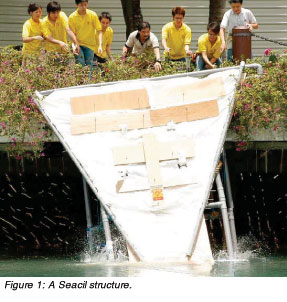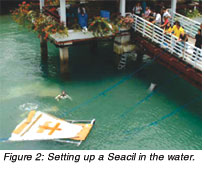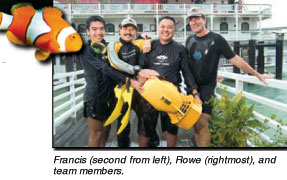|
by Kwang Wei TJAN and Lay Leng TAN
 coral reef plays an important role in nature. Besides furnishing a habitat for sea flora and fauna, the ecosystem is richly endowed with marine resources. The reef platform helps reduce flooding and coastal erosion and affords sheltered anchorage for shipping vessels and small boats. coral reef plays an important role in nature. Besides furnishing a habitat for sea flora and fauna, the ecosystem is richly endowed with marine resources. The reef platform helps reduce flooding and coastal erosion and affords sheltered anchorage for shipping vessels and small boats.
Once, over 60 offshore islands and patch reefs surrounded Singapore, most of them south of the mainland. The 1970s major land-reclamation projects destroyed coral and sea-life habitats. Shipping-channel dredging and earth-spoils dumping worsened the condition, and an increase in water turbidity severely affected other organisms lucky enough to be still alive.
 To address the critical situation in the Labrador and Sentosa waters where encroaching sub-sea mud kills the coral, the Singapore Maritime Academy at the Singapore Polytechnic, led by manager Captain Frederick Francis, has developed an artificial reef called Seacil. The project seeks to create an underwater garden and open-sea aquarium on the extensive sub-sea mud to revitalise marine flora and fauna. To address the critical situation in the Labrador and Sentosa waters where encroaching sub-sea mud kills the coral, the Singapore Maritime Academy at the Singapore Polytechnic, led by manager Captain Frederick Francis, has developed an artificial reef called Seacil. The project seeks to create an underwater garden and open-sea aquarium on the extensive sub-sea mud to revitalise marine flora and fauna.
The brainchild of Charles Rowe, a maritime consultant who teaches part-time at the polytechnic, the Seacil constitutes a concrete structure deliberately placed on the seabed to mimic the characteristics of a natural reef. It is constructed on land without using metals and materials that would oxidise and directly or indirectly poison marine flora and fauna. The frame consists of recycled hollow plastic tubes, stretched with large web-like plastic structures serving as the foundation (Figure 1) to provide sufficient surface for organism attachment.
 For waters with thick mud, the builders erect long, recycled plastic pipes on the seabed to support the Seacils. Divers first shift the structure to deeper waters using airbags and buckets, then lower it onto mud sub-sea surfaces (Figure 2). Cement weighs the structure down and anchors it to the upright pipes. High-pressure air pumped down through a hose flushes away the mud from the Seacil, thus allowing the establishment of marine life. Team members graft hard coral onto the platform and then introduce anemones and clown fish. They lash several Seacils together to form pods on which to create the underwater garden. For waters with thick mud, the builders erect long, recycled plastic pipes on the seabed to support the Seacils. Divers first shift the structure to deeper waters using airbags and buckets, then lower it onto mud sub-sea surfaces (Figure 2). Cement weighs the structure down and anchors it to the upright pipes. High-pressure air pumped down through a hose flushes away the mud from the Seacil, thus allowing the establishment of marine life. Team members graft hard coral onto the platform and then introduce anemones and clown fish. They lash several Seacils together to form pods on which to create the underwater garden.
The team comprising Singapore Polytech students and volunteer divers first harvested coral from the affected zones off Sentosa and Labrador. They selected healthy undamaged coral without bleached or dead areas and removed them carefully off the reef. After transferring colonies of coral by carrier bags -- fully submerged to minimise exposure stress -- they secured the carrier bags to handle straps, then inflated them slowly until the bags lifted off the reef floor. Underwater ropes guided the bags of coral to the receiving sites where divers unloaded them for subsequent grafting onto the Seacil platforms.
 Environmentally concerned team members have successfully conducted a pilot project of transplanting coral onto the Seacil off Sentosa near the Riverboat. The small underwater garden has an impressed-current system and underwater lights powered by solar energy, to produce a nice light-up effect at night (Figure 3). The group received the Singapore Polytechnic's Research and Development Commendation Award for the work. The team is currently transplanting hundreds of corals inLabrador waters to save them from destruction by port-expansion activities in the area. So far the survival of healthy coral has been encouraging. Environmentally concerned team members have successfully conducted a pilot project of transplanting coral onto the Seacil off Sentosa near the Riverboat. The small underwater garden has an impressed-current system and underwater lights powered by solar energy, to produce a nice light-up effect at night (Figure 3). The group received the Singapore Polytechnic's Research and Development Commendation Award for the work. The team is currently transplanting hundreds of corals inLabrador waters to save them from destruction by port-expansion activities in the area. So far the survival of healthy coral has been encouraging.
The Seacil demonstrates numerous advantages in terms of simplicity, ease of construction, and low cost. Using environmentally friendly or recycled materials, it does not need expensive components and chemicals employed in existing coral-transplant structures and processes. The project has great implications for conserving and invigorating the underwater ecosystem, with potential educational and ecotourism value.
 The Seacil showcase at Labrador will serve as an educational tool in promoting appreciation of the marine environment, providing a hands-on approach in creative and innovative teaching, and enabling practical input and design from learning participants. With its varying set-ups, the simple system can encourage other educational institutions to learn and to contribute jointly their own designs to create underwater gardens in Singapore waters and elsewhere. The Seacil showcase at Labrador will serve as an educational tool in promoting appreciation of the marine environment, providing a hands-on approach in creative and innovative teaching, and enabling practical input and design from learning participants. With its varying set-ups, the simple system can encourage other educational institutions to learn and to contribute jointly their own designs to create underwater gardens in Singapore waters and elsewhere.
On the commercial front, the Seacil enables the creation of live rock for use in marine aquariums, reducing dependency on natural coral, especially the hard coral imported for fish tanks. With promotion of a rich ecosystem, the artificial reef can attract aquatic life for fisheries, sport anglers, and divers. The plentiful substrate can serve as a source of food for algae or shellfish. Once implemented, the Seacil can open up opportunities for sea farms by providing cookies or food released on a time basis for pelagic schools of fish. Employment opportunities exist for the old and the handicapped in hand-making the components of the platform using recycled materials.
Perhaps the greatest impact comes from the setting up of artificial reefs and rescue operations of marine life from areas designated for reclamation where the Seacil can serve as a planting or a transfer base. It can replace habitat loss elsewhere or in places where particular substrates are threatened, help preserve endangered sea life, even encourage new growth to revive many threatened underwater ecosystems everywhere.
The researchers' future field surveys will focus on tagging the coral and monitoring the survivability of these underwater organisms. Team members do not plan to patent or protect the invention as they feel they should share the information for the good of the marine environment.
 Click here to download the full issue for USD 6.50 Click here to download the full issue for USD 6.50
|


 coral reef plays an important role in nature. Besides furnishing a habitat for sea flora and fauna, the ecosystem is richly endowed with marine resources. The reef platform helps reduce flooding and coastal erosion and affords sheltered anchorage for shipping vessels and small boats.
coral reef plays an important role in nature. Besides furnishing a habitat for sea flora and fauna, the ecosystem is richly endowed with marine resources. The reef platform helps reduce flooding and coastal erosion and affords sheltered anchorage for shipping vessels and small boats.
 To address the critical situation in the Labrador and Sentosa waters where encroaching sub-sea mud kills the coral, the Singapore Maritime Academy at the Singapore Polytechnic, led by manager Captain Frederick Francis, has developed an artificial reef called Seacil. The project seeks to create an underwater garden and open-sea aquarium on the extensive sub-sea mud to revitalise marine flora and fauna.
To address the critical situation in the Labrador and Sentosa waters where encroaching sub-sea mud kills the coral, the Singapore Maritime Academy at the Singapore Polytechnic, led by manager Captain Frederick Francis, has developed an artificial reef called Seacil. The project seeks to create an underwater garden and open-sea aquarium on the extensive sub-sea mud to revitalise marine flora and fauna.
 For waters with thick mud, the builders erect long, recycled plastic pipes on the seabed to support the Seacils. Divers first shift the structure to deeper waters using airbags and buckets, then lower it onto mud sub-sea surfaces (Figure 2). Cement weighs the structure down and anchors it to the upright pipes. High-pressure air pumped down through a hose flushes away the mud from the Seacil, thus allowing the establishment of marine life. Team members graft hard coral onto the platform and then introduce anemones and clown fish. They lash several Seacils together to form pods on which to create the underwater garden.
For waters with thick mud, the builders erect long, recycled plastic pipes on the seabed to support the Seacils. Divers first shift the structure to deeper waters using airbags and buckets, then lower it onto mud sub-sea surfaces (Figure 2). Cement weighs the structure down and anchors it to the upright pipes. High-pressure air pumped down through a hose flushes away the mud from the Seacil, thus allowing the establishment of marine life. Team members graft hard coral onto the platform and then introduce anemones and clown fish. They lash several Seacils together to form pods on which to create the underwater garden.
 Environmentally concerned team members have successfully conducted a pilot project of transplanting coral onto the Seacil off Sentosa near the Riverboat. The small underwater garden has an impressed-current system and underwater lights powered by solar energy, to produce a nice light-up effect at night (Figure 3). The group received the Singapore Polytechnic's Research and Development Commendation Award for the work. The team is currently transplanting hundreds of corals inLabrador waters to save them from destruction by port-expansion activities in the area. So far the survival of healthy coral has been encouraging.
Environmentally concerned team members have successfully conducted a pilot project of transplanting coral onto the Seacil off Sentosa near the Riverboat. The small underwater garden has an impressed-current system and underwater lights powered by solar energy, to produce a nice light-up effect at night (Figure 3). The group received the Singapore Polytechnic's Research and Development Commendation Award for the work. The team is currently transplanting hundreds of corals inLabrador waters to save them from destruction by port-expansion activities in the area. So far the survival of healthy coral has been encouraging.
 The Seacil showcase at Labrador will serve as an educational tool in promoting appreciation of the marine environment, providing a hands-on approach in creative and innovative teaching, and enabling practical input and design from learning participants. With its varying set-ups, the simple system can encourage other educational institutions to learn and to contribute jointly their own designs to create underwater gardens in Singapore waters and elsewhere.
The Seacil showcase at Labrador will serve as an educational tool in promoting appreciation of the marine environment, providing a hands-on approach in creative and innovative teaching, and enabling practical input and design from learning participants. With its varying set-ups, the simple system can encourage other educational institutions to learn and to contribute jointly their own designs to create underwater gardens in Singapore waters and elsewhere.
 Click here to download the full issue for USD 6.50
Click here to download the full issue for USD 6.50